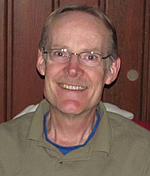Exploring Shanghai
By Francis Eberle
Posted on 2010-11-22
The final day in Shanghai was busy and we all had to be, as our guide put it, “sticky rice and not loose noodles.” After breakfast we left for the Jade Buddhist Temple, then went on to a silk factory, ate lunch before heading to do some quick shopping in old Shanghai, then off to the Shanghai museum, with more shopping at the “knock off” market, before we finally had dinner. No one complained since we knew we could sleep on the 15-hour trip home the next day.
The Jade Buddhist Temple was spectacular. Our visit coincided with one of the two (I think) worship days each month, and the place was packed. People were worshiping, making wishes, burning incense, burning their wishes in large fires and generally milling around in the various rooms with a Buddha. There was quite an excited air in the room. We were able to view the Jade Buddha, with people worshiping there. People also bought oil to keep there lamps burning in support of the Buddha as they stood in front of the Buddha and made their silent prayers.
no images were found
Outside in the courtyard, someone in our group and I were approached by a young man with identification around his neck indicating that he worked in the temple. He wanted us to rub the fat Buddha’s belly for good luck. He took us to another quiet room on the second floor of one of the buildings to rub the Buddha’s stomach, which we both did and took pictures. (The sign next to the Buddha said taking photos was prohibited.) He then showed us around the little exhibit area and tried to persuade us that we should buy several items. We didn’t and he seemed very disappointed.
We then went to the silk factory where the factory docent talked about the silk making process—by caterpillars—and the spinning process—by people, or machines in this case. There are two kinds of cocoons and one is used for threads—the single cocoon- and the other one—the double cocoon—is used for quilts. (The thread is continuous in the single cocoon but not with the double cocoon.) The docent then took us into the factor store room and told us the benefit of silk as compared to other fabrics. (She too was very persuasive about how we would be so happy if we bought some silk.)
After lunch we visited the Shanghai museum and learned more about China’s history. This museum had an array of amazing displays of old art, furniture, sculpture and ceramics. I have a nephew who is a potter, so I focused mostly on the pottery and ceramics. There were pots that were made in 236 AD that were quite spectacular.
To wrap up the day, a few people continued their shopping and we all met for dinner. For our last dinner in China we were ready but not exactly prepared for the upcoming treat planned for us. We were placed in a very large dining room hall which was separated by a six-foot removable wall. On the other half of the hall there was a large birthday party for a man who was turning 50. Our guide said usually the Chinese don’t celebrate with such a large group until the person turns 80, 90, or 100. There was very loud music—so loud you couldn’t talk at the tables–as well as balancing acts and singing. Someone at our table said you could have changed the words on the projector screen to Spanish and you could have been in Mexico. During the mayhem of noise and celebration someone in our group was able to obtain some of the birthday cake, which resulted in many of the birthday guests joining our tables for cake, cheers, and pictures. This was an unexpected cultural lesson for us in a changing China. Happy, commercial, and loud. Sound familiar? Happy Birthday, China.
Disclaimer: The views expressed in this blog post are those of the author(s) and do not necessarily reflect the official position of the National Science Teaching Association (NSTA).



